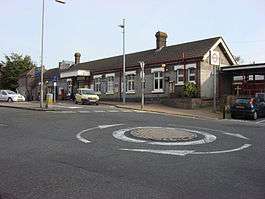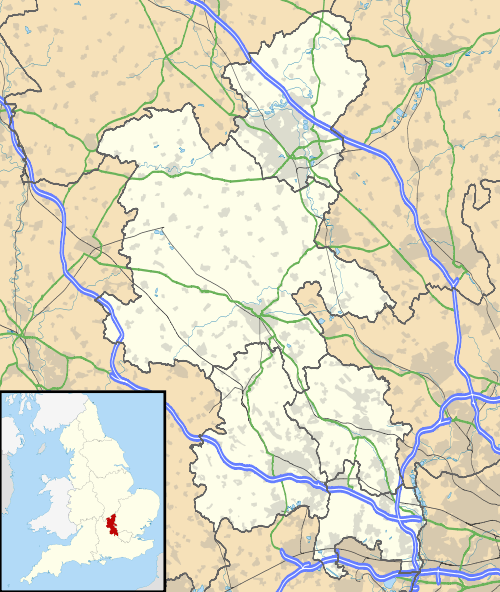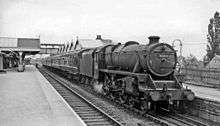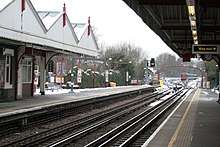Amersham station
Amersham is a London Underground and National Rail station in Amersham in the Chiltern district of Buckinghamshire, England.
| Amersham | |
|---|---|
 Station entrance | |
 Amersham Location of Amersham in Buckinghamshire | |
| Location | Amersham |
| Local authority | Buckinghamshire |
| Managed by | London Underground[1] |
| Station code | AMR |
| Number of platforms | 3 |
| Accessible | Yes (Southbound only)[2] |
| Fare zone | 9 |
| London Underground annual entry and exit | |
| 2014 | |
| 2015 | |
| 2016 | |
| 2017 | |
| 2018 | |
| National Rail annual entry and exit | |
| 2014–15 | |
| 2015–16 | |
| 2016–17 | |
| 2017–18 | |
| 2018–19 | |
| Key dates | |
| 1892 | Opened |
| 4 July 1966 | Goods yard closed[6] |
| Other information | |
| External links | |
| WGS84 | 51.674°N 0.607°W |
Amersham station is a terminus of the London Underground's Metropolitan line.[7] It is 23.7 miles (38.1 km) northwest of Charing Cross, making it the second furthest Underground station from central London and the second most westerly station of the whole London Underground system, after Chesham.[8] It is in Travelcard Zone 9[7] (previously zone D).
Amersham station is also served by Chiltern Railways, which run trains between London Marylebone and Aylesbury. From Aylesbury a shuttle service to Princes Risborough provides access to through services between Marylebone and Birmingham Snow Hill. The journey times between Amersham and Central London range between 33 and 60 minutes. The journey time between Amersham and Chalfont & Latimer is about three and a half minutes.[9]
History

The station was opened on 1 September 1892 as part of the Metropolitan Railway (Met) extension from Chalfont Road (now Chalfont & Latimer) to Aylesbury.[10] On 12 March 1922, its name was changed to "Amersham & Chesham Bois", but the original name was restored during 1937.

From 16 March 1899, the Great Central Railway served the station through its extension to Marylebone.[11] Consequently, the station became joint Met/GCR owned. On 1 January 1923, the GCR became part of the London and North Eastern Railway (LNER)[11] as part of the Railways Act 1921, and on 1 July 1933, the Met became part of the London Passenger Transport Board (LPTB), thus becoming the Metropolitan line of the London Underground. On 1 January 1948, the LNER was nationalised, its share of the station initially coming under the control of the Eastern Region of British Railways, before being transferred to the London Midland Region in 1958.[11]
On 12 September 1960, the tracks from Rickmansworth to Amersham were electrified,[10] partially fulfilling plans first proposed some thirty years earlier. The rolling stock ordered by London Underground as part of this project, the A60 stock, is named after Amersham.
Service Changes
When the sectorisation of British Rail took place in 1982, services to Aylesbury on what had by now become the London to Aylesbury Line came under the operation of Network SouthEast. Following the privatisation of British Rail in the mid-1990s, these services have been provided by Chiltern Railways.
From December 2010, off-peak Metropolitan line services to and from Amersham were reduced to two per hour,[10] with a corresponding increase in through services on the Chesham branch. This is a return to the historically normal frequency of two Metropolitan trains per hour from the four Metropolitan trains per hour service that had been operating for the previous five years. Including the Chiltern Railways services, Amersham still has four trains an hour to London in total, with extra trains from both operators at peak hours. Metropolitan line services are divided 50:50 between Amersham and Chesham.[10] This is expected to divide park and ride or kiss and ride motorist users more evenly between the two stations and help spread the load on local roads, though the change was made purely for operational reasons.[12]
The station today
The station is located on Station Approach, Amersham.[13] Ticket barriers are in operation at the station.[1]
In 2009, because of financial constraints, Transport for London (TfL) decided to stop work on a project to provide step-free access at Amersham and five other stations, on the grounds that these are relatively quiet stations and some are already one or two stops away from an existing step-free station.[14][note 1] In 2017, TfL announced that Amersham station would receive funding for step-free access, with work commencing in 2018.[15] It is due for completion in 2020.[16]
Services
Services at Amersham are operated by Chiltern Railways and London Underground on the Metropolitan line. The off-peak service at the station is:
- 2 tph to Aldgate (All Stations)
- 2 tph to London Marylebone
- 2 tph to Aylesbury of which 1 continues to Aylesbury Vale Parkway
| Preceding station | Following station | |||
|---|---|---|---|---|
| Terminus | Metropolitan line | |||
| Great Missenden | Chiltern Railways London to Aylesbury Line |
Chalfont & Latimer | ||
| Disused railways | ||||
| Preceding station | Following station | |||
towards Aylesbury | Metropolitan line | |||
Notes and references
Notes
- The next station towards London, Chalfont & Latimer, and Chesham station, around 2 miles (3.2 km) north, both have step-free access.[7]
References
- National Rail Enquiries - Station facilities for Amersham
- "Step free Tube Guide" (PDF). Transport for London. May 2020. Archived (PDF) from the original on 7 August 2020.
- "Multi-year station entry-and-exit figures (2007-2017)" (XLSX). London Underground station passenger usage data. Transport for London. January 2018. Retrieved 22 July 2018.
- "Station Usage Data" (CSV). Usage Statistics for London Stations, 2018. Transport for London. 21 August 2019. Retrieved 27 April 2020.
- "Station usage estimates". Rail statistics. Office of Rail Regulation. Please note: Some methodology may vary year on year.
- Hardy, Brian, ed. (March 2011). "How it used to be - freight on The Underground 50 years ago". Underground News. London: London Underground Railway Society (591): 175–183. ISSN 0306-8617.
- Standard Tube Map (PDF) (Map). Not to scale. Transport for London. May 2020. Archived (PDF) from the original on 7 July 2020.
- Open Street Map
- "Tube Facts - Stations that it takes the longest to travel between". Archived from the original on 3 April 2015. Retrieved 29 March 2015.
- Feather, Clive. "Metropolitan line". Clive's Underground Line Guides. Archived from the original on 30 August 2014.
- "The Great Central Railway - History". Archived from the original on 24 December 2013. Retrieved 29 March 2015.
- "'S' stock making its mark". Modern Railways. London. December 2010. p. 46.
- Google Maps - Amersham Station
- "Disability and Deaf Equality Scheme (DES) 2009-2012". TfL. Archived from the original on 25 April 2012. Retrieved 1 December 2010.
- "Tube station to go step-free". Bucks Free Press. Retrieved 28 December 2018.
- "Next six Underground stations to go step-free". Transport for London. Retrieved 28 December 2018.
Further reading
- Butt, R. V. J. (1995). The Directory of Railway Stations: details every public and private passenger station, halt, platform and stopping place, past and present (1st ed.). Sparkford: Patrick Stephens Ltd. ISBN 978-1-85260-508-7. OCLC 60251199.
- Jowett, Alan (2000). Jowett's Nationalised Railway Atlas (1st ed.). Penryn, Cornwall: Atlantic Transport Publishers. ISBN 978-0-906899-99-1. OCLC 228266687.
External links
| Wikimedia Commons has media related to Amersham station. |
- Train times and station information for Amersham station from National Rail
- Official London Underground website
- Station on navigable O.S. map